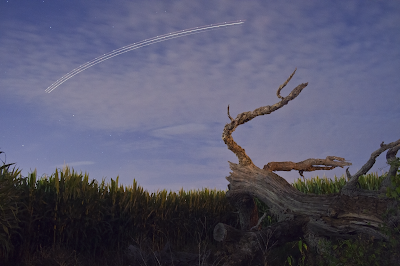Light painting is harder than it looks. I went out last weekend with my friend Drew to do some light painting with my Canon Rebel XT and shutter remote. I left my shutter lock on with the idea that I would just stack some of the photos later to create more elaborate light trail and light painting scenes (more than I could do in 20 seconds during a single exposure).
I learned a lot along the way, here are the most important lessons that I came away with:
1. Light painting is very different from star trail photography. With star trails, you want to get to a very very dark location to get as many stars as possible.
With light painting, you don't want to be in pitch black - because then you might as well be standing in a bathroom with the door closed. With light painting there is a greater need for context and some kind of subject matter. The light trails should enhance the scene - but they are not the entire scene in themselves.
 |
| Lighting the ground saved this shot because without it the lights appear to be floating in a boring black void. |
2. As cool and 3D as the light trail might look at times, to the camera the light is completely 2D. This means that
it's very difficult to show depth - such as running down a wooded path at night. The camera doesn't know you're going down a path into the distance, it just sees the light with very little vertical and lateral movement. Essentially, the light trail looks 2D and showing depth takes extra effort (and in my case luck).
 |
| Rainbow light tunnel (with legs) |
3. Less is more. Unless you are going to fill the entire frame with abstract colored lights, the
best shots I came away with included accents and effects that make the photo more interesting. But again, don't think about it as painting the subject matter, but enhancing the subject matter with interesting light paintings.
 |
| Light bridge with faces |
4.
Drawing is hard, drawing with invisible paint in a 3D environment is even harder. I came away with a stick figure drawing that was actually rather successful (as far as stick figures go) because it is very difficult to connect lines, write words, etc. Your light will leave a path in the camera, but not in the air - so connecting lines, drawing circles, and making lines overlap is very tricky.
 |
| Stick figure light painting |
















































